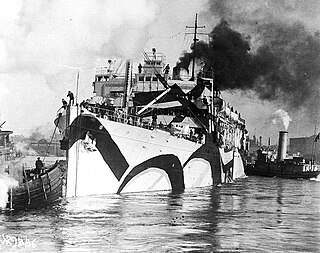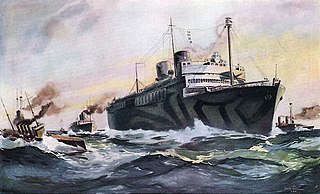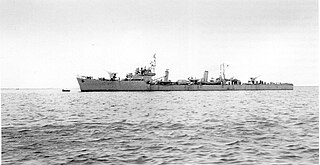
USS Siboney (CVE-112/AKV-12) was a Commencement Bay-class escort carrier of the United States Navy. She was the second ship named for Siboney, Cuba, the Cuban Village near which troops of Theodore Roosevelt's Rough Riders fought during the Spanish–American War.

USS Comfort (AH-3) was a hospital ship for the United States Navy in World War I. She was the sister ship of USS Mercy (AH-4) but the two ships were not of a ship class. Comfort was known as SS Havana in passenger service for the Ward Line, and as USAT Havana in United States Army service before her Navy service. Her name was restored to Havana in 1927, and she was renamed SS Yucatán in 1935, and SS Agwileon in 1941. In World War II, she was known as USAT Agwileon and USAHS Shamrock in service for the United States Army.

USS Orizaba (ID-1536/AP-24) was a transport ship for the United States Navy in both World War I and World War II. She was the sister ship of Siboney but the two were not part of a ship class. In her varied career, she was also known as USAT Orizaba in service for the United States Army, and as SS Orizaba in interwar civilian service for the Ward Line, and as Duque de Caxias (U-11) as an auxiliary in the Brazilian Navy after World War II.

USS Peoria (PF-67), a Tacoma-class frigate, was the third ship of the United States Navy to be named after Peoria, Illinois.
USS Execute (AM-232) was an Admirable-class minesweeper built for the United States Navy during World War II. She was originally ordered and laid down as USS PCE-905, the lead ship of the PCE-905 class of patrol craft. She was reclassified as an Admirable-class minesweeper by the time of her June 1944 launch, and named Execute by the time of her November 1944 commissioning. After service in the Pacific during World War II, she was decommissioned in August 1946 and placed in reserve. While she remained in reserve, Execute was reclassified as MSF-232 in February 1955 but never reactivated. In 1962, she was sold to the Mexican Navy and renamed ARM DM-03. In 1994, she was renamed ARM General Juan N. Méndez (C51). She was stricken in July 2001, but her ultimate fate is not reported in secondary sources.

USS Siboney (ID-2999) was a ship transport for the United States Navy during World War I. She was the sister ship of USS Orizaba (ID-1536) but neither was part of a ship class. Launched as SS Oriente, she was soon renamed after Siboney, Cuba, a landing site of United States forces during the Spanish–American War. After her navy service ended, she was SS Siboney for the New York & Cuba Mail Steamship Co.. The ship was operated under charter by American Export Lines beginning in late 1940. During World War II she served the U.S. Army as transport USAT Siboney and as hospital ship USAHS Charles A. Stafford.

USS Ampere (PCE-919/AM-359/YDG-11/ADG-11) was originally planned as a PCE-905-class patrol craft for the United States Navy, PCE-919, and laid down as an Admirable-class minesweeper, named Drake, for the male duck. Before she was commissioned, her name was cancelled and she was reclassified as a District Degaussing Vessel. She was later renamed Ampere, after the ampere, a unit of electric current, which takes its name from the French physicist André-Marie Ampère.
USS Buttress (PCE-878/ACM-4) was an auxiliary minelayer (ACM) in the United States Navy during World War II. This ship and USS Monadnock (ACM-10) were the only ACMs not previously U.S. Army mineplanters.
USS Dipper (AM-357) was an Admirable-class minesweeper built for the United States Navy during World War II. The ship was ordered and laid down as PCE-905-class patrol craft USS PCE-917 but was renamed and reclassified before her July 1944 launch as Dipper (AM-357). Dipper was launched 26 July 1944 by Willamette Iron and Steel Works, Portland, Oregon ; sponsored by Miss A. L. Gaffney; and commissioned 26 December 1945, Lieutenant H. S. Pomeroy, USNR, in command. Dipper sailed from Portland 11 January 1946 to join the U.S. 19th Fleet (Reserve) at San Diego, California, four days later. She provided various services for this group until placed out of commission in reserve 15 January 1947. She was reclassified MSF-357, 7 February 1955. Dipper was sold for scrap on 5 January 1961.

USS Lamar (PCE-899)/USCGC Lamar (WTR-899) was a PCE-842-class patrol craft acquired by the U.S. Navy during World War II for the task of patrolling assigned ocean areas or protecting larger ships in convoy.

BRP Sultan Kudarat (PS-22) was a Miguel Malvar-class corvette of the Philippine Navy. She was originally built as USS PCE-881, a PCE-842-class patrol craft for the United States Navy during World War II. In 1961 she was transferred to South Vietnam for service in the Republic of Vietnam Navy as RVNS Đống Đa II (HQ-07). She was acquired by the Philippine Navy on April 1976, and was commissioned later on as RPS Sultan Kudarat (PS-22). Along with other World War II-era ships of the Philippine Navy, Sultan Kudarat was considered one of the oldest active fighting ships in the world, until her retirement in 05 July 2019.
BRP Datu Marikudo (PS-23) was a Malvar-class corvette of the Philippine Navy. She was originally built as USS PCE(R)-853, a PCE(R)-848-class patrol craft for the United States Navy during World War II. She was renamed USS Amherst on 15 February 1956. In February 1970, Amherst was decommissioned and transferred to South Vietnam for service in the Republic of Vietnam Navy as RVNS Vạn Kiếp II (HQ-14). She remained in South Vietnamese service until the collapse of that country in 1975. Vạn Kiếp II was one of several ships that fled from South Vietnam to the Philippines. She was then commissioned into the Philippine Navy on 5 April 1976 and named in honor of Datu Marikudo. Along with other World War II-era ships of the Philippine Navy, Datu Marikudo was considered one of the oldest active fighting ships in the world until her decommissioning.

BRP Cebu (PS-28) was a Miguel Malvar-class corvette of the Philippine Navy. She was originally built as USS PCE-881, a PCE-842-class patrol craft for the United States Navy during World War II and patrolled the Alaskan coast during that war. She was decommissioned from the U.S. Navy and transferred to the Philippine Navy in July 1948 and renamed RPS Cebu (E-28) after the Philippine province of the same name. The ship was decommissioned on 1 October 2019. Along with other World War II-era ships of the Philippine Navy, Cebu was considered one of the world's oldest fighting ships during her active service.
RPS Leyte (PS-30) was a Miguel Malvar-class corvette of the Philippine Navy. She was originally built as USS PCE-885, a PCE-842-class patrol craft for the United States Navy during World War II. She was decommissioned from the U.S. Navy and transferred to the Philippine Navy in July 1948 and renamed Leyte. The ship was decommissioned from the Philippine Navy in 1978 after she ran aground and was damaged beyond repair.

The fourth USS Scorpion was a steam yacht in commission in the United States Navy from 1898 to 1899, 1899 to 1901, and 1902 to 1927.
ROKS Dangpo was a patrol craft of the Republic of Korea Navy (ROKN). Originally built as USS PCE-842, a PCE-842-class patrol craft for the United States Navy during World War II. Dangpo was acquired by South Korea on 13 December 1961 and sunk by North Korean coastal artillery fire on 19 January 1967.

Hatsuzakura was one of 23 escort destroyers of the Tachibana sub-class of the Matsu class built for the Imperial Japanese Navy during the final stages of World War II. The ship was used to repatriate Japanese personnel after the war until 1947. Mid-year the destroyer was turned over to the Soviet Union and was commissioned that same year. She was renamed Vyrazitelny later that year. When the ship was converted into a target ship in 1949, she was renamed TsL-26. The vessel was ordered to be scrapped a decade later.

Shii was one of 23 escort destroyers of the Tachibana sub-class of the Matsu class built for the Imperial Japanese Navy during the final stages of World War II. Completed in March 1945, she struck a mine in June, but was only lightly damaged. The ship was used to repatriate Japanese personnel after the war until 1947. Mid-year the destroyer was turned over to the Soviet Union, renamed Volny and was commissioned that same year. She was renamed TsL-24 and converted into a target ship two years later; the ship was ordered to be scrapped in 1960.

USS PCE-872 was a PCE-842-class patrol craft for the United States Navy during World War II. She was renamed Caribe after being acquired by the Cuban Navy on 1 October 1947.

USS PCE-867 was a PCE-842-class patrol craft for the United States Navy during World War II. She was renamed ROCSYong Tai (PCE-41) and ROCS Shan Hai (PCE-62) after being acquired by the Republic of China Navy on 7 February 1948.














